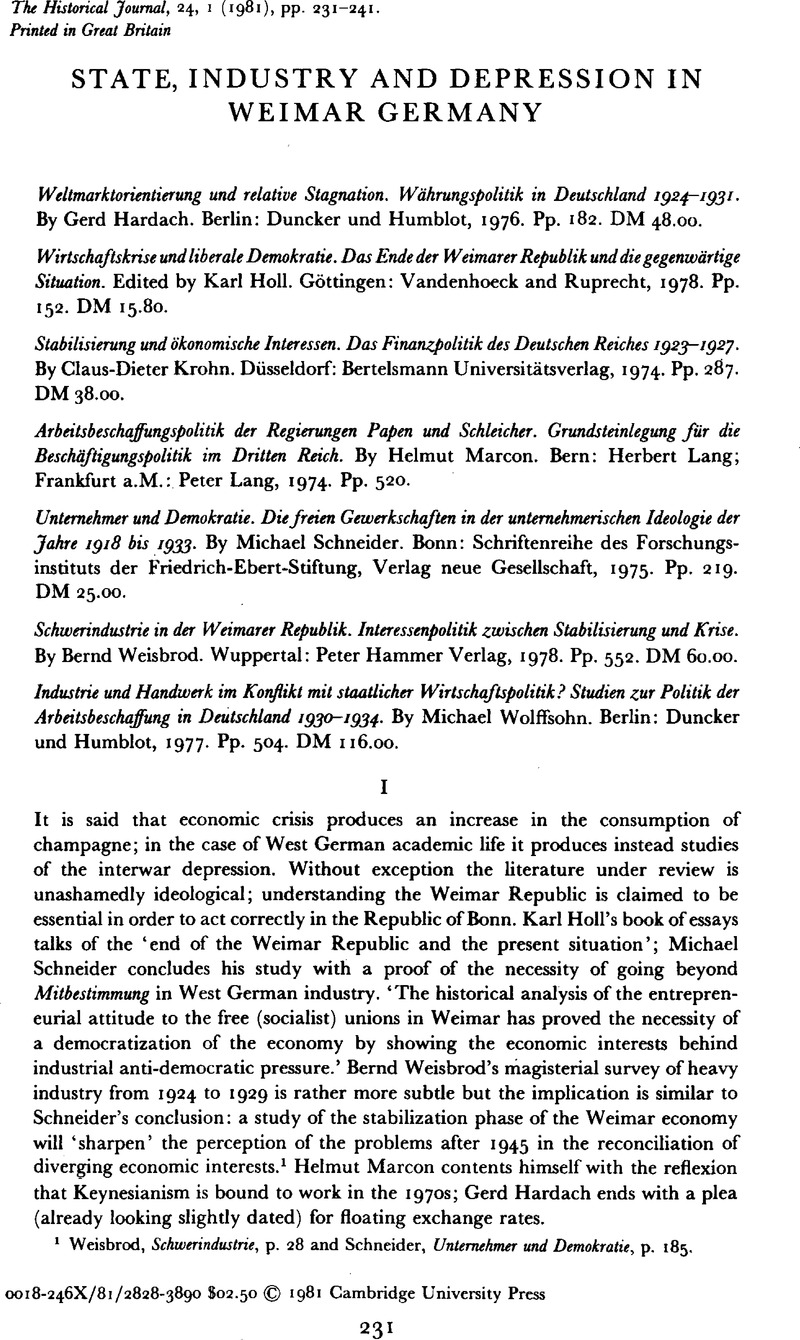Published online by Cambridge University Press: 11 February 2009

1 Weisbrod, Schwerindustrie, p. 28 and Schneider, Unternehmer und Demokratie, p. 185.
2 See Werner Conze, ‘Die politischen Entscheidungcn in Deutschland 1929–1931’ in Die Staats- und Wirtschafts-Krise des Deutschen Retches 1929/33, eds. Werner Conze and Hans Raupach (Stuttgart, 1967). Helbich, Wolfgang J., Die Reparationen in der Ära Brüning. Zur Bedeutung des Young-Plans fiir die deutsche Politik 1930 bis 1932 (Berlin, 1962).Google Scholar
3 See Bundesarchiv Koblenz, NL Luther 340 and 370.
4 Hardach, Weltmarktorientierung, p. 149.
5 Quoted in Hardach, Weltmarktorientierung, p. 64.
6 See Krohn, Stabilisierung und ökonomische Interessen, p. 224.
7 See Bundesarchiv Koblenz, NL Luther 354. Note of 17 Jan. 1933.
8 See Weisbrod, Schwerindustrie, pp. 63–7 and pp. 71–3.
9 Weisbrod, Schwerindustrie, p. 415.
10 Schneider, Unternehmer und Demokratie, p. 126.
11 Wolffsohn, Industrie und Handwerk, p. 74.
12 See Turner, H. A., ‘The Ruhrlade, secret cabinet of German heavy industry in the Weimar Republic’, Central European History, iii (1970), 195–227.CrossRefGoogle Scholar
13 Keynes, J. M., The general theory of employment, interest and money (1936; reprinted London, 1973). p. 383.Google Scholar
14 This view has been challenged by Peter Temin, ‘The beginning of the depression in Germany’, Economic History Review, 2nd ser. xxiv (1971), 240–8; and the argument there is developed in Temin's book, Did monetary forces cause the Great Depression? (New York, 1976). Temin's account has been criticized by M. E. Falkus, ‘The German business cycle in the 1920s’, EcHR, 2nd ser. xxviii (1975), 451–65, and by T. Balderston, ‘The German business cycle in the 1920s’, EcHR, 2nd ser. xxx (1977), 159–61. Both Temin and Falkus believe that inventory investment should play a major role in providing an explanation of the German economic downturn. Temin finds a fall in inventory investment from the end of 1927, or before American investment began to be withdrawn; Falkus argues that inventory investment was (and is) influenced by changes in interest rates. The inventory investment figures used by Temin and Falkus are queried by Balderston, who argues that there was only a slight fall in non-agricultural inventory investment in 1928. The problem still remains of why entrepreneurial expectations and with them projected investments began to drop at the end of 1927: the alternative explanations given include (a) falling public investment intentions in 1927–8 (but in fact public investment did not decline very much before 1930); (b) the high interest rates caused by domestic monetary policy (which certainly caused a stock market slump in May 1927 but whose further economic effects it is impossible to isolate. Certainly the result of the policy was to turn large firms at least to look for foreign money); and (c) high wage settlements. This was probably the most important moment in industrialists’ calculations.
Two comments on this debate are appropriate: first, there is evidence, which Balderston is aware of, of mounting American criticism of German investment from late 1927. This criticism was given a boost by the attack of the Reparations Agent, Parker Gilbert, on Reich financial policy in reports of July and November 1927 (and Gilbert's attitude was widely believed to have been influenced significantly by Schacht's comments on Reich finance). So there was pressure from Wall Street. Secondly, a debate over the causes of the initial downturn is bound to neglect the issue of why a recession became so deep and long a crisis. Here American withdrawal and world depression were essential; as American confidence and expanding world trade had been to Germany in the recovery.